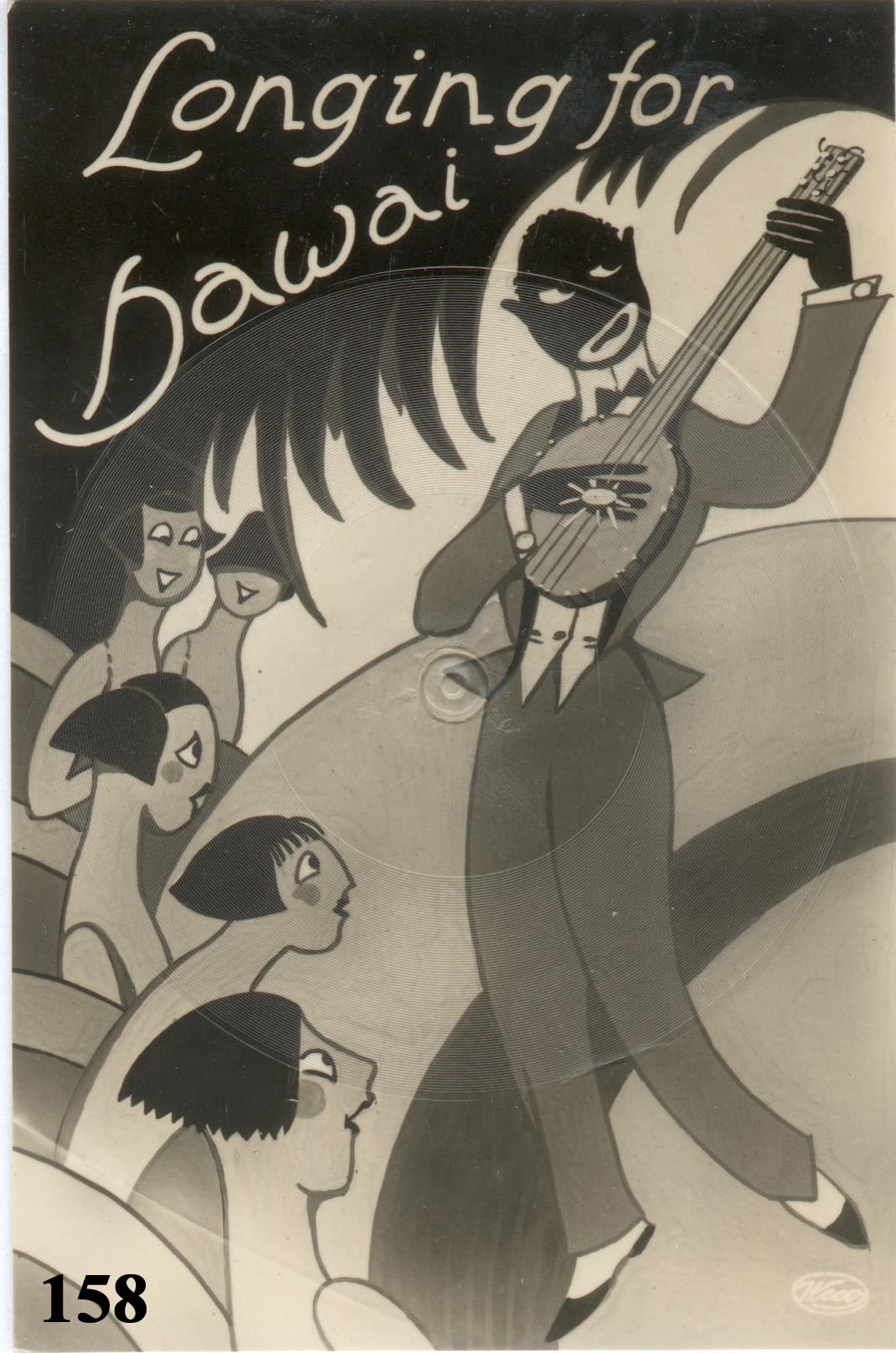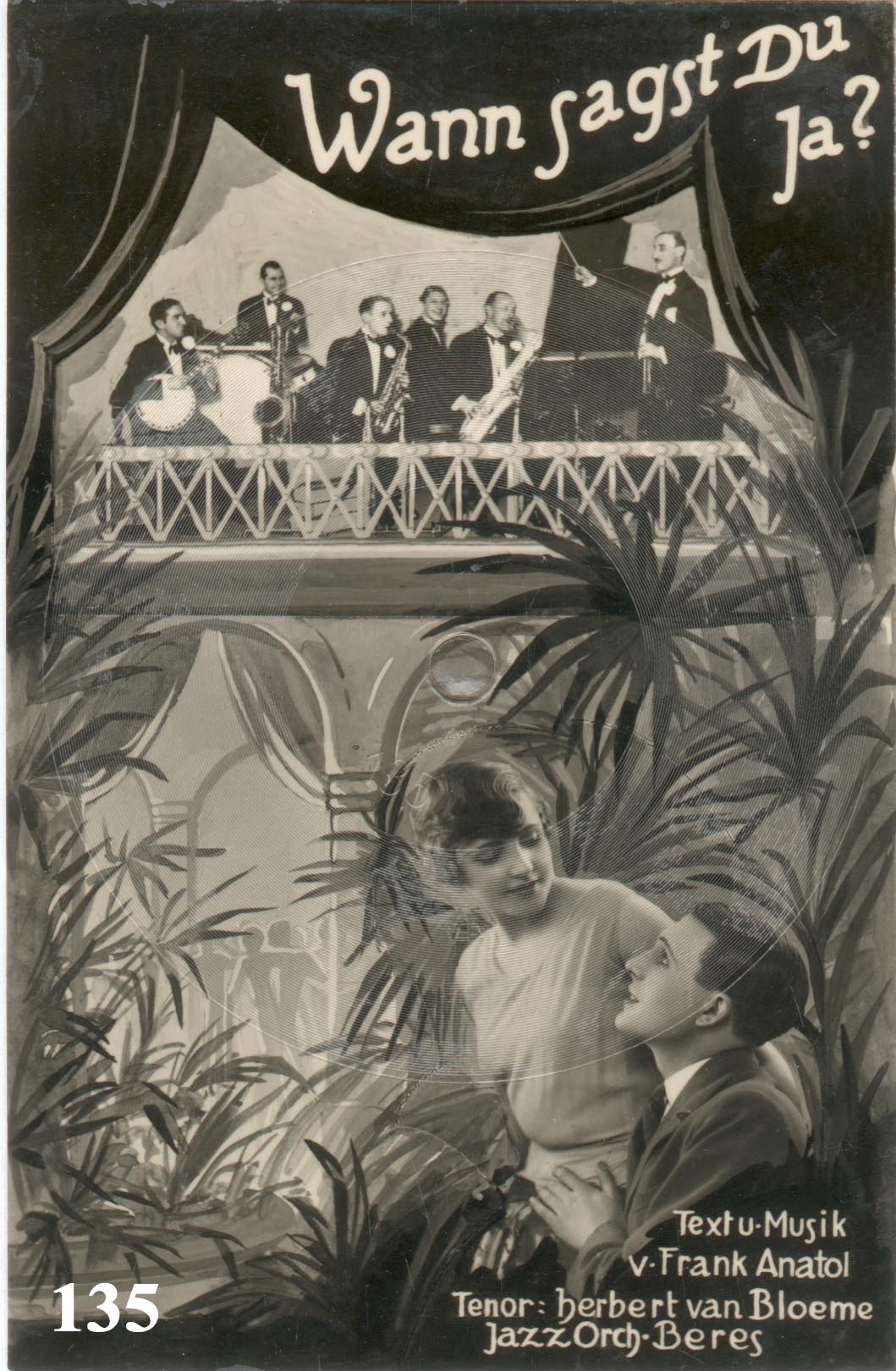 |
OnlineDiscographyWeco-Tonbild-Postkarten
|
 |
Weco-Tonbild-Postkarten
Please note: This is a
discographical catalog - items are NOT available for sale from us
Achtung: Dies ist
eine Discographie - die Platten stehen NICHT zum Verkauf
Acknowledgements:
Peter Bastiné, Lyle Boehland, Dave
Easterla, Helmfried Luers, Margarida Estanyol
Ullate, Jos
Hocks, Antonio Popp, Hermann Sachse, Paul Sonntag, Kirk Thorsteinson, Helmut
Weiß
Introductory notes:
The basic idea of a gramophone postcard is to glue a single sided
miniature disc record onto a postcard and punch a center hole through
both card and disc. For further details see the exploratory history of the
phono postcard. In contrast. The Weco cards are entirely coated with a
translucent material into which the grooves of the electric recordings
were pressed.
Weco:
Little is known about the Weco company background. The only flyer ever
found (undated, but listing cards in the range 133 to 219) identifies the
supplier as Arthur Meier, Hamburg 20, Nissenstr.11. Most of the
music was published by "Verlag moderne Tanzmusik", at Moritz-Strasse
11, Berlin, Germany. Some cards show a company logo, the word "Weco" enclosed in an
oval. The appearance of Weco phono cards occured at the time of the
introduction of sound films. All Weco recordings are electrical. It had therefore been speculated that Weco stands for the Western Electric
Company. However, thanks to the untiring research by Jos Hocks it is clear that
the Weco trademark was owned by Hans Wiesner & Co. An advertisement
was placed in "Photographische Chronik", vol.36, no.5, 29 January
1929. (In German the letter "W" is pronounced "Ve" as
in Venezuela).
Hans Wiesner, originally from the Berlin suburb Niederschöneweide, ran his business from Cöpenicker Str. 152, Berlin SO 33 (later SO 36). Wiesner was an art publisher, he ran a bromide photographic printing business and advertised as a "Luxuspapierfabrik", i.e. a de luxe paper factory. His business is listed in the Berlin address books from 1921 to 1932. His business partners are not yet identified, but another ad located by collector Peter Bastiné identifies the owners as Hans Wiesner and Günther Wiesner, both residing at Köpenickerstr. 152, Berlin.
It seems that at least some cards were still being manufactured after the Nazi takeover in 1933, as a copy of Weco 134 has been found were the names of Jewish performers and compositions have been obscured.
Weco also produced "regular" postcards without recorded sound. The phono cards ("Tonbild-Postkarten") are numbered from 101 upwards, the highest number identified is 234. The earlier cards were organized as "Mappen" (portfolio files), of four cards each. Each "Mappe" was identified by a Roman numeral, from I [1] upwards, the highest number identified is XX [20], see Mappe III, Mappe IV, Mappe XI (all from collection Antonio Popp). Weco also manufactured custom cards to order, and those have not been allocated a number. In most cases, matrix numbers are identical to order or catalog numbers. Weco recommended that their products should be played with Pegasus "Winkelnadeln" and enclosed such flyers with their cards. Some individual postcards are reported to have been protected by (fragile) cellophane protective sleeves (image 1) , (image 2). Cards other than custom pressings were normally distributed through the stationary trade, but occasionally also through record dealers.
From 1929 Wiesner applied for patents in various countries:
|
Ansichtspostkarte mit akustischen Lautaufzeichnungen |
|
Country
Germany |
|
Patent
number
545253 |
|
Application
date
29.10.1929 |
|
Publication
date
27.2.1932 |
|
|
|
Carte postale illustrée
avec enregistrements acoustiques |
|
Country
France |
|
Patent
number
704396 |
|
Application
date
27.10.1930 |
|
Publication
date
19.5.1931 |
|
|
|
Improvements in or
relating to picture postcards with acoustic records |
|
Country
United Kingdom |
|
Patent
number
353343 |
|
Application
date 28.10.1930 |
|
Publication
date 23.7.1931 |
|
|
|
Picture postcard
with acoustic record |
|
Country
Canada |
|
Patent
number
315838 |
|
Application
date
? |
|
Publication
date
6.10.1931 |
|
Page
10, Page 2,
Page 3, Page
4, Page 5,
Page 6, Page
7, Page 8,
Page 9 |
|
|
|
Procedimiento para
la fabrication de tarjetas postales ilustradas con inscripciones
fonopostales ilustradas con inscripciones fonográficas |
|
Country
Spain |
|
Patent
number
120269 |
|
Application
date 23.10.1930 |
|
Publication
date 1.1.1931 |
In contrast to its competitors, the Weco company in Germany mostly used excellent black-and-white photographs, but there are also graphic designs and combinations. Musical content and graphic designs often matched, and renowned artists were employed to record recent compositions. Most of the earlier cards identified artist, composition and authors on the picture side, but later cards just reproduce the image of a beautiful girl or a pair of lovers, while basic details (usually the title) are listed on the reverse. The same masters occasionally surface with different designs and different languages printed on the back.
Weco also produced advertising cards and custom pressings under the trademarks Weco, Weco-Tonbild and Wecoton, including in square and circular shapes. Some cards were marketed as CEKO brand: Ceko No.4, Ceko No.5 and reverse of Ceko No.5
Two disc-shaped cards have been found which use the numbers and images of regular Weco-Postcards: No.203 (front - reverse) and 228 (front - reverse). The reverse sides bear information in longhand which suggests they were trials or tests, although rectangular sleeves have also been found.
Although the Weco phono cards seem to have been quite popular in Germany, Austria, Czechoslovakia, France, The Netherlands, Spain and other countries (including Uruguay) – at least 234 cards were produced in quick succession between 1929 and 1932 – the economic depression wiped this high quality product off the market..
Numerical listing: Attention: This is a large file which may require a long loading time. Be patient...
Links to images by matrix numbers
|
100 |
|||||||||||||||||||
|
141 |
154 |
159 |
|||||||||||||||||
|
174 |
175 |
||||||||||||||||||
|
184 |
185 |
186 |
187 |
||||||||||||||||
|
202 |
204 |
205 |
206 |
207 |
211 |
212 |
213 |
214 |
216 |
217 |
218 |
219 |
|||||||
|
220 |
221 |
224 |
225 |
226 |
227 |
228 |
229 |
230 |
231 |
232 |
235 |
236 |
237 |
238 |
239 |
||||
|
|
|
|
|
|
|
Wecoton was a subsidiary of Weco for custom-made records and advertising purposes.
It is not presently possible to determine the total number of cards produced, and information on matrix numbers etc can only be derived from physical autopsy of the artifacts. Some cards have same numbers with different photos. Some cards are known to exist with and without description on the photo side, or with and without lyrics an the reverse side. Some matrices show a suffix "B" (for Bachaphon?) or a suffix -1 (a take identification?). If you have additions or corrections: Please contact us by e-mail: Rainer E. Lotz
Literature:
Peter Bastiné, Weco Tonbild-Postkarten 1929-1931 aus Berlin (Hamburg: Eigenverlag, 2011)
LAST UPDATE: 2011-11-05
Rainer E. Lotz
Rotdornweg 81
53177 Bonn, Germany
Phone(International): +49-228-352808 / Phone(National): 0228-352808
Fax (International): +49-228-365142 /
Fax (National): 0228-365142
E-Mail:
Rainer Lotz







